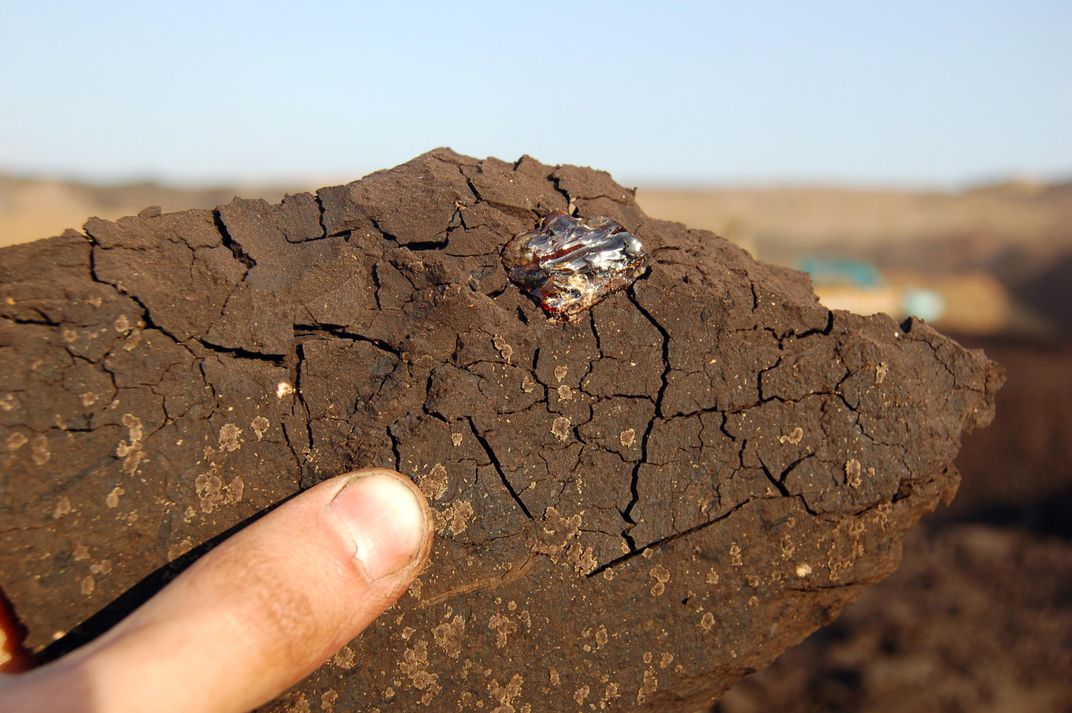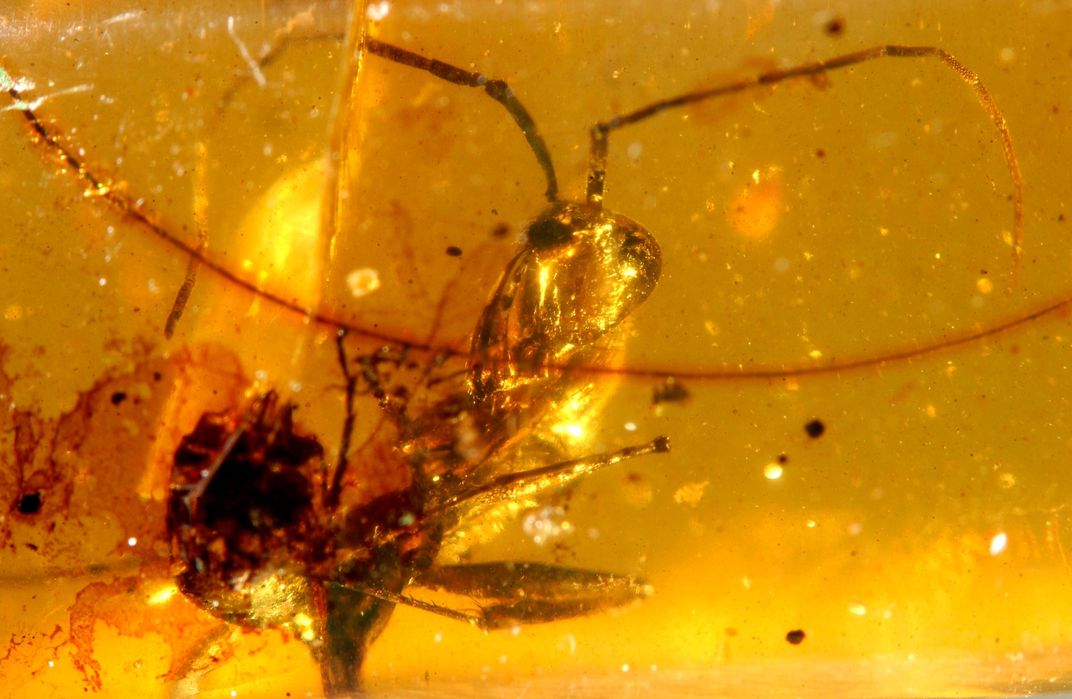These Tiny Saber-Toothed Terrors Are Among the World’s Oldest Ants
Analysis of insects entombed in amber shows that the “hell ants” were among the first to diverge from the original ant-wasp ancestor
/https://tf-cmsv2-smithsonianmag-media.s3.amazonaws.com/filer/57/eb/57eb5ebd-14a7-469c-a347-e0da23c432be/grimaldi_ant_tusk1.jpg)
Ants: They’re the model of cooperative hustle and super-efficient picnic pests. Unless you come into contact with the searing bite of a bullet ant or fire ant, you probably ignore the diminutive insects as a mere nuisance.
But perhaps you'd pay more attention if you ran into a particular kind of ant from the Cretaceous called a haidomyrmecine. Dubbed “hell ants” for their scimitar-like mandibles, five species have been identified over the last century in samples of Burmese, French and Canadian amber.
Now, analysis of these trapped ants and their spectacular headgear reveals them to be among the oldest true ants in the world. The insects lived between 78 and 99 million years ago and seem to be among the very earliest to diverge from the original ant-wasp family group.
“There are no ant fossils older than these, full stop,” says Phillip Barden, a postdoctoral fellow at Rutgers University. “But we estimate from molecular data and DNA analysis that they diversified 20 to 60 million years earlier.”
These ancient ants had long trigger hairs on their faces and dense mats of whiskers on their foreheads, which presumably acted like stopping-plates so an ant wouldn’t run itself through with its own swords. Based on these and other traits, Barden thinks the hell-ants’ jaws would have hinged upward, so that the ant skewered its still unknown prey—possibly soft-bodied insects—into the sky. Modern trap-jaw ants, whose mandibles snap shut laterally, use their jaws in much in the same way.
Even creepier, slight grooves on the inside of the hell-ants’ mandibles might have been used to funnel its prey’s bodily fluids down towards the mouth, Barden suggests, though this is just speculation for now.
In short, not only were these insects saber-toothed ants, they might have been vampire saber-toothed ants.
Despite their screaming weirdness, the ants somehow went virtually unnoticed for the better part of the 20th century. Entomologist Theodore Dru Alison Cockerell catalogued the first known haidomyrmecine specimen in 1920 but left it undescribed. The ant simply sat on a shelf at the Natural History Museum in London until 1996, when a Russian paleoentomologist, Gennady Dlussky, finally described the species and gave it its colorful name.
“Unfortunately, it is not so unusual for museum specimens to have a long shelf life before description,” said Ryan McKellar, an invertebrate paleontologist with the Royal Saskatchewan Museum who has also studied hell-ants in amber.
“Cockerell was a very active researcher, which makes it a bit puzzling how such a distinctive specimen escaped his focus. Then again, when you are dealing with insects that are 3 to 8 millimeters in total body length, and hiding in dark orange amber, one can imagine how it could have been overlooked as part of a larger batch.”
Determining the age of the ant in the amber, as well as where it fits into the evolutionary time scale, is an indirect business. Unlike Jurassic Park, where the fictional scientists extract DNA directly from an entombed specimen, paleoentomologists don’t destroy their samples by drilling into them, a tactic that probably wouldn’t yield any genetic material anyway. Instead scientists determine the surrounding amber’s age—crystals from the geologic layer in which the amber is found are dated based on the radioactive decay of their uranium-lead isotopes.
As for the ancient ants’ evolutionary placement, Barden and his colleague David Grimaldi at the American Museum of Natural History analyzed the insect's physical features—including head and antennae shape, mandible and thorax structure and a gland on the thorax unique to ants. The team then compared those traits with the characteristics of members of living ant groups and their outside relatives, such as bees and stinging wasps.
A series of analyses produced an ancestral tree that explains how that diversity might have evolved in the fewest number of steps. Based on that work, the researchers were able to conclude that haidomyrmecines sat on some of the first branches of the ant family tree.
“We only have a few portholes into early ant evolution,” Barden says. “That’s been a problem with ants in general. We don’t know the sister group, or most closely related group, to ants. Some say bees, then a more recent paper said stinging wasps, so we took a few different types—we included all of them. The idea is that you’ll get this polarity in the evolutionary tree for how closely these things match with each other.”
Barden and Grimaldi’s findings, published in February in Current Biology, may change subtly as more specimens are uncovered, says McKellar. But for now, the work lays out a plausible scenario.
“We are limited by the current amber record in our search for well-preserved ant fossils,” McKellar says. “Work on amber from places like Spain and Lebanon may extend the record of ants deeper into the early Cretaceous. The sort of detailed analysis Barden’s group conducted will be very difficult to expand without amber preservation.”

Finding more entombed ants presents its own set of challenges. For instance, Barden describes collecting amber at a lignite mine in India, where the fossilized tree resin is usually discarded as a by-product and even burned to repel—ironically—insects.
But perhaps, like the hell-ants, the next bizarre discovery has already been scooped up and is waiting in a museum's collections for its chance to stretch our imaginations.
“If you asked a second grader what ants looked like in the time of dinosaurs, they’d probably draw this stuff,” Barden says. “But the early lineages are totally different from what we have today, and we wouldn’t know if it weren’t for these fossils. When E.O. Wilson described the first Cretaceous ant in 1967, it set the tone for what to expect, but this is more bizarre than anything we could have ever imagined.”
/https://tf-cmsv2-smithsonianmag-media.s3.amazonaws.com/accounts/headshot/Michelle-Donahue.jpg)


/https://tf-cmsv2-smithsonianmag-media.s3.amazonaws.com/accounts/headshot/Michelle-Donahue.jpg)